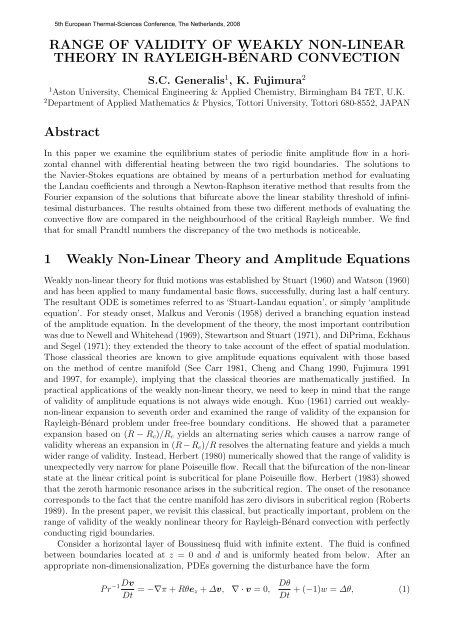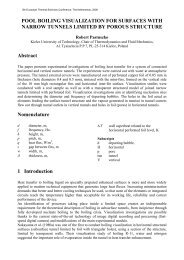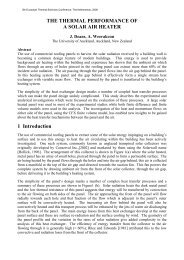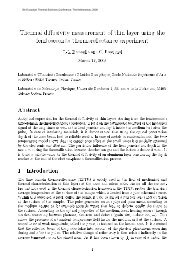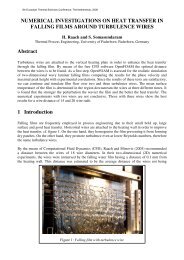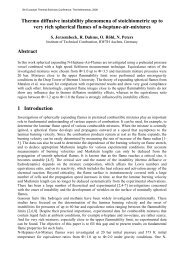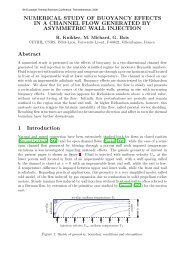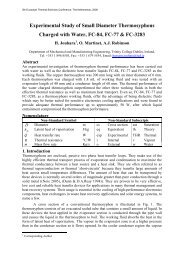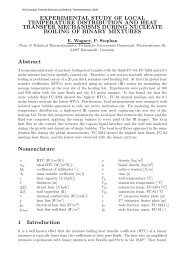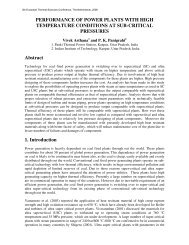Sotos Generalis, Birmingham, GB - Eurotherm 2008
Sotos Generalis, Birmingham, GB - Eurotherm 2008
Sotos Generalis, Birmingham, GB - Eurotherm 2008
Create successful ePaper yourself
Turn your PDF publications into a flip-book with our unique Google optimized e-Paper software.
5th European Thermal-Sciences Conference, The Netherlands, <strong>2008</strong><br />
RANGE OF VALIDITY OF WEAKLY NON-LINEAR<br />
THEORY IN RAYLEIGH-BÉNARD CONVECTION<br />
S.C. <strong>Generalis</strong> 1 , K. Fujimura 2<br />
1 Aston University, Chemical Engineering & Applied Chemistry, <strong>Birmingham</strong> B4 7ET, U.K.<br />
2 Department of Applied Mathematics & Physics, Tottori University, Tottori 680-8552, JAPAN<br />
Abstract<br />
In this paper we examine the equilibrium states of periodic finite amplitude flow in a horizontal<br />
channel with differential heating between the two rigid boundaries. The solutions to<br />
the Navier-Stokes equations are obtained by means of a perturbation method for evaluating<br />
the Landau coefficients and through a Newton-Raphson iterative method that results from the<br />
Fourier expansion of the solutions that bifurcate above the linear stability threshold of infinitesimal<br />
disturbances. The results obtained from these two different methods of evaluating the<br />
convective flow are compared in the neighbourhood of the critical Rayleigh number. We find<br />
that for small Prandtl numbers the discrepancy of the two methods is noticeable.<br />
1 Weakly Non-Linear Theory and Amplitude Equations<br />
Weakly non-linear theory for fluid motions was established by Stuart (1960) and Watson (1960)<br />
and has been applied to many fundamental basic flows, successfully, during last a half century.<br />
The resultant ODE is sometimes referred to as ‘Stuart-Landau equation’, or simply ‘amplitude<br />
equation’. For steady onset, Malkus and Veronis (1958) derived a branching equation instead<br />
of the amplitude equation. In the development of the theory, the most important contribution<br />
was due to Newell and Whitehead (1969), Stewartson and Stuart (1971), and DiPrima, Eckhaus<br />
and Segel (1971); they extended the theory to take account of the effect of spatial modulation.<br />
Those classical theories are known to give amplitude equations equivalent with those based<br />
on the method of centre manifold (See Carr 1981, Cheng and Chang 1990, Fujimura 1991<br />
and 1997, for example), implying that the classical theories are mathematically justified. In<br />
practical applications of the weakly non-linear theory, we need to keep in mind that the range<br />
of validity of amplitude equations is not always wide enough. Kuo (1961) carried out weaklynon-linear<br />
expansion to seventh order and examined the range of validity of the expansion for<br />
Rayleigh-Bénard problem under free-free boundary conditions. He showed that a parameter<br />
expansion based on (R − R c )/R c yields an alternating series which causes a narrow range of<br />
validity whereas an expansion in (R − R c )/R resolves the alternating feature and yields a much<br />
wider range of validity. Instead, Herbert (1980) numerically showed that the range of validity is<br />
unexpectedly very narrow for plane Poiseuille flow. Recall that the bifurcation of the non-linear<br />
state at the linear critical point is subcritical for plane Poiseuille flow. Herbert (1983) showed<br />
that the zeroth harmonic resonance arises in the subcritical region. The onset of the resonance<br />
corresponds to the fact that the centre manifold has zero divisors in subcritical region (Roberts<br />
1989). In the present paper, we revisit this classical, but practically important, problem on the<br />
range of validity of the weakly nonlinear theory for Rayleigh-Bénard convection with perfectly<br />
conducting rigid boundaries.<br />
Consider a horizontal layer of Boussinesq fluid with infinite extent. The fluid is confined<br />
between boundaries located at z = 0 and d and is uniformly heated from below. After an<br />
appropriate non-dimensionalization, PDEs governing the disturbance have the form<br />
−1 Dv<br />
P r<br />
Dt = −∇π + Rθe z + ∆v, ∇ · v = 0,<br />
Dθ<br />
Dt<br />
+ (−1)w = ∆θ, (1)
5th European Thermal-Sciences Conference, The Netherlands, <strong>2008</strong><br />
0.015<br />
|w(1/2)|<br />
0.005<br />
3<br />
5<br />
7<br />
9<br />
11<br />
13<br />
15<br />
17<br />
19<br />
21<br />
23<br />
25<br />
27<br />
29<br />
0.0 0.025 0.05<br />
(R − R c )/R c<br />
Figure 1: Results of the calculations for the non-linear flow for P r = 0.001. The streamwise<br />
harmonics use k c = 3.11632355, and R c is the critical Rayleigh number for Rayleigh-Bnard<br />
convection: R c = 1707.76178. In order to measure the agreement between the two methods<br />
studied in this work we use the amplitude of the z-component of the velocity field evaluated at<br />
midplane: |w(1/2)|. The truncation levels of the Stuart-Landau equation (2) are also provided.
5th European Thermal-Sciences Conference, The Netherlands, <strong>2008</strong><br />
where P r = ν 0<br />
, R = α 0gδT d 3<br />
, d being the depth of the fluid layer, and δT being a temperature<br />
κ 0 ν 0 κ 0<br />
difference between the top and bottom boundaries.<br />
Under the assumption that the solution of (1) is 2π/k c -periodic, (1) is invariant under<br />
x → x+l(mod 2π/k c ) and x → −x together with u → −u, where k c is the critical wavenumber.<br />
Let the solution of (1) be written as (v, π, θ) T = A(t)(Ψ(z), Π(z), Θ(z)) T e ikcx + c.c. + · · · .<br />
Orthogonal group O(2) acts on A ∈ R 2 as A → A e iϕ for 0 ≤ ϕ < 2π and A → A. The equation<br />
for A(t) generated by O(2)-equivariant vector field is written as Ȧ = A f(|A|2 ; µ), where µ =<br />
(R − R c )/R c ∈ R and f : R × R → R. Taylor expansion of the invariant function f about the<br />
origin yields the Stuart-Landau equation<br />
˙ A = A (f µ (0)µ + f |A| 2(0)|A| 2 + · · · ) = σA + ∑ n=1<br />
λ 2n+1 |A| 2n A. (2)<br />
To derive equation (2) from (1), we apply the refined version of the amplitude expansion<br />
scheme (See Herbert 1983 or Fujimura 1989, for example). We first rewrite (1) into a simplified<br />
form [ ∂<br />
∂t S + L(R) ]<br />
ψ = N (ψ, ψ) for ψ = (v, π, θ) T . (3)<br />
The ψ is subject to homogeneous boundary conditions<br />
Hψ = 0 at z = 0, 1, i.e., v = 0 and θ = 0 at z = 0, 1. (4)<br />
Let us assume the solution ψ to be two-dimensional and seek ψ in the form of Fourier series<br />
ψ(x, t) =<br />
∞∑<br />
j=−∞<br />
Ψ j (z, t) e ijkcx where Ψ −j = Ψ j . (5)<br />
Each Fourier component Ψ j is governed by<br />
[ ∂<br />
∞∑<br />
∂t S j + L j (R)]<br />
Ψ j = N(Ψ j−m , Ψ m ), S j = S| ∂x→ijkc,∂ z→d/dz, L j = L| ∂x→ijkc,∂ z→d/dz. (6)<br />
m=−∞<br />
Following (2), we expand Ψ j in |A| 2 such that<br />
Ψ j (z, t) = ∑ n=1<br />
Φ j,j+2(n−1) (z)|A| 2(n−1) A j and Ψ 0 (z, t) = ∑ n=1<br />
Φ 0,2n (z)|A| 2n . (7)<br />
At O(|A|), we have<br />
[σS 1 + L 1 (R)] Φ 11 = 0 subject to H 1 Φ 11 = 0 at z = 0, 1 (8)<br />
where H j = H| ∂x →ijk c ,∂ z →d/dz. 1<br />
are governed by<br />
At O(|A| 2 ), the mean-flow-distortion and the second harmonic<br />
[(σ + ¯σ)S 0 + L 0 (R)] Φ 02 = N 02 and [2σS 2 + L 2 (R)] Φ 22 = N 22 , (9)<br />
where N 02 = N(Φ 11 , Φ 11 ) + N(Φ 11 , Φ 11 ) and N 22 = N(Φ 11 , Φ 11 ). At O(|A| 3 ), the deformation of<br />
the fundamental is governed by<br />
[(2σ + ¯σ)S 1 + L 1 (R)] Φ 13 = N 13 − λ 3 S 1 Φ 11 , (10)<br />
where N 13 = N(Φ 11 , Φ 22 ) + N(Φ 22 , Φ 11 ) + N(Φ 11 , Φ 02 ) + N(Φ 02 , Φ 11 ).<br />
1 We formally retained the general form of homogeneous boundary conditions although the conditions here<br />
are very simple. In what follows, Φ jn is subject to the boundary conditions H j Φ jn = 0 at z = 0, 1.
5th European Thermal-Sciences Conference, The Netherlands, <strong>2008</strong><br />
5<br />
4<br />
3<br />
|w(1/2)|<br />
2<br />
1<br />
3<br />
5<br />
7<br />
9<br />
11<br />
13<br />
15<br />
17<br />
19<br />
21<br />
23<br />
25<br />
27<br />
29<br />
0.0 0.2 0.4 0.6<br />
(R − R c )/R c<br />
Figure 2: Results of the calculations for the non-linear flow for P r = 7.0. The streamwise<br />
harmonics use k c = 3.11632355, and R c is the critical Rayleigh number for Rayleigh-Bnard<br />
convection: R c = 1707.76178. In order to measure the agreement between the two methods<br />
studied in this work we use the amplitude of the z-component of the velocity field evaluated at<br />
midplane: |w(1/2)|. The truncation levels of the Stuart-Landau equation (2) are also provided.
5th European Thermal-Sciences Conference, The Netherlands, <strong>2008</strong><br />
For Re σ = 0, the first Landau constant λ 3 is determined from the solvability condition<br />
for (10). For non-vanishing Re σ, on the other hand, we follow Watson (1960) and set Φ 13 =<br />
χ (1)<br />
13 − λ 3 χ (2)<br />
13 . Equation (10) is then divided into<br />
[(2σ + ¯σ)S 1 + L 1 (R)] χ (1)<br />
13 = N 13 and [(2σ + ¯σ)S 1 + L 1 (R)] χ (2)<br />
13 = S 1 Φ 11 . (11)<br />
Since Re σ ≠ 0, the first equation of (11) is solvable whereas the second equation has a solution<br />
of the form of χ (2)<br />
13 = Φ 11 /(σ + ¯σ) so that Φ 13 = χ (1)<br />
13 − λ 3 Φ 11 /(σ + ¯σ). At this stage, following<br />
Herbert (1983), we define the amplitude of the fundamental mode at a reference point z 0 ∈ (0, 1)<br />
by requiring that<br />
Φ 11 (z 0 ) = 1, Φ 1n (z 0 ) = 0 for n ≥ 3. (12)<br />
Equation (12) then yields<br />
λ 3 = (σ + ¯σ)χ (1)<br />
13 (z 0 ). (13)<br />
Formal analysis to the higher-order approximation is straightforward. The n-th Landau<br />
constant λ 2n+1 is given by<br />
λ 2n+1 = n(σ + ¯σ)χ (1)<br />
1,2n+1(z 0 ) (14)<br />
where χ (1)<br />
1,2n+1 is a solution of<br />
[<br />
]<br />
{(n + 1)σ + n¯σ}S 1 + L 1 (R) χ (1)<br />
1,2n+1 = N 1,2n+1 −<br />
and N 1,2n+1 is a summation of nonlinear terms arising at O(|A| 2n+1 ).<br />
2 Fully Non-Linear Solution of the PDEs<br />
n∑<br />
{jλ 2(n−j)+3 + (j − 1)λ 2(n−j)+3 } S 1 Φ 1,2j−1<br />
Since there is no preferred direction in the horizontal plane, the most dangerous modes have<br />
wavevectors on the critical circle with radius k c . Let us restrict ourselves on the situation similar<br />
to that in section 1 and consider the roll-structure which is 2π/k c -periodic in the x-direction and<br />
uniform in the y-direction. Two-dimensional equilibrium solutions were obtained numerically<br />
by using the collocation method combined with the Newton-Raphson iterative method for some<br />
high enough truncation numbers M, N. Details of the numerical method to obtain non-linear<br />
solutions were presented recently in Nagata & <strong>Generalis</strong> (2002) and <strong>Generalis</strong> & Nagata (2003,<br />
2004). Although the non-linear solutions bifurcate from the conduction state along the neutral<br />
curve of the linearized theory it is important to obtain converged solutions that represent the<br />
flow globally. The latter is important as the series<br />
N∑ M∑<br />
w =<br />
a nm (1 − ζ 2 ) 2 T n (ζ)e imkcx ,<br />
(15)<br />
θ =<br />
n=0 m=−M<br />
N∑<br />
M∑<br />
n=0 m=−M<br />
j=2<br />
b nm (1 − ζ 2 )T n (ζ)e imk cx<br />
must be truncated at a certain level of the harmonics that are taken into account. Here<br />
ζ = 2z −1. This pre-determined truncation level is also present in the weakly non-linear theory<br />
of the previous section and in the case of Poiseuille flow Herbert (1980) showed the deviation<br />
from agreement between the two methods for small amplitudes, i.e. in the vicinity of the neutral<br />
curve. This was attributed by Herbert (1980) to the limited scope of the weakly non-linear<br />
theory as the latter approximates the mean flow rather poorly already at small amplitudes and<br />
therefore the use of the weakly non-linear theory should only be employed at regions that are<br />
very close to the neutral curve.<br />
(16)
5th European Thermal-Sciences Conference, The Netherlands, <strong>2008</strong><br />
5<br />
4<br />
3<br />
|w(1/2)|<br />
2<br />
1<br />
3<br />
5<br />
7<br />
9<br />
11<br />
13<br />
15<br />
17<br />
19<br />
21<br />
23<br />
25<br />
27<br />
29<br />
0.0 0.2 0.4 0.6<br />
(R − R c )/R c<br />
Figure 3: Results of the calculations for the non-linear flow for P r = 1000. The streamwise<br />
harmonics use k c = 3.11632355, and R c is the critical Rayleigh number for Rayleigh-Bnard<br />
convection: R c = 1707.76178. In order to measure the agreement between the two methods<br />
studied in this work we use the amplitude of the z-component of the velocity field evaluated at<br />
midplane: |w(1/2)|. The truncation levels of the Stuart-Landau equation (2) are also provided.
5th European Thermal-Sciences Conference, The Netherlands, <strong>2008</strong><br />
3 Numerical Results and Concluding Remarks<br />
In order to examine the convergence of the results between the two methods, we evaluated nonlinear<br />
solutions for various values of the Prandtl number. Non-linear amplitudes were derived<br />
from equations of the form (Nagata & <strong>Generalis</strong> 2002, <strong>Generalis</strong> & Nagata 2003)<br />
Ax + x T Bx = 0, (17)<br />
where by x i we denote collectively the unknown two-dimensional amplitudes that we evaluate<br />
at the collocation points z i = cos((i + 1)π/(N + 2)), i = 0, · · · , N. The rank of the square<br />
matrices A, B is (N + 1)(2M + 1). The Newton-Raphson iterative method is employed in order<br />
to obtain solutions to the resulting finite system of equations.<br />
As can be seen from Figures 1-3 the agreement between the two methods in the vicinity of<br />
the critical Rayleigh number is very good provided that P r ≥ O(1). If the latter condition<br />
is not satisfied then even a large number of non-linear terms in the amplitude expansion or a<br />
large number of harmonics in the Newton-Raphson iterative method 2 does not make the two<br />
methods converge to the same values of the quantity used here (|w(1/2)|). For P r < 0.25,<br />
λ 5 , λ 9 , λ 11 , and λ 15 are positive whereas λ 3 , λ 7 , λ 13 , λ 17 , and λ 19 are negative. Therefore the<br />
RHS of (2) is almost alternating. This situation is similar to the one in plane Poiseuille flow. All<br />
the positive λ ′ s for small P r change their sign and become negative almost simultaneously at<br />
around P r = 0.25. For P r > 0.25, the λ 2n+1 on the RHS of (2) are all negative. The agreement<br />
between the two methods for moderate and large values of the Prandtl number testifies to the<br />
fact that the range of validity of weakly non-linear expansion is fairly extensive. For P r > 0.25<br />
the range of validity of the Stuart-Landau equation (2) is 0 < (R − R c )/R c < 1 or even wider,<br />
whereas it is within 0 < (R − R c )/R c < 0.02 for P r < 0.25. The apparent narrow range<br />
of agreement for small values of P r even when higher order non-linear terms are taken into<br />
account in the amplitude equation and a large number of harmonics is taken into account in<br />
the Newton-Raphson iterative method is a matter of on-going investigation.<br />
Finally we note that Kuo (1961) reported that, other than (R − R c )/R c , the (R − R c )/R<br />
drastically improves the range of validity of the parameter expansion. As P r decreases, however,<br />
the alternating feature recovers and the convergence of the expansion gets worse. For P r =<br />
0.001, the range of validity is almost comparable with our result. Therefore, an introduction<br />
of the parameter expansion in terms of (R − R c )/R is not expected to improve the range of<br />
validity for small P r fluids under rigid-rigid boundary conditions.<br />
References<br />
[1] Carr, J. 1981, Applications of centre manifold theory, (Springer Verlag).<br />
[2] Cheng, M. & Chang, H.-C. 1990, A generalized sideband stability theory via center manifold<br />
projection, Phys. Fluids, A2, 1364–1379.<br />
[3] R.C. DiPrima, W. Eckhaus & L.A. Segel, 1971, Non-linear wave-number interaction in<br />
near-critical two-dimensional flows, J. Fluid Mech., 49, 705–744.<br />
[4] Fujimura, K. 1989, The equivalence between two perturbation methods in weakly nonlinear<br />
stability theory for parallel shear flows, Proc. R. Soc. A, 424, 373–392.<br />
[5] Fujimura, K. 1991, Methods of centre manifold and multiple scales in the theory of weakly<br />
non-linear stability for fluid motions, Proc. R. Soc. A, 434, 719–733.<br />
2 For P r < 1 the value M = 91 was used in order to establish that the two methods agreed.
5th European Thermal-Sciences Conference, The Netherlands, <strong>2008</strong><br />
[6] Fujimura, K. 1997, Centre manifold reduction and the Stuart-Landau equation for fluid<br />
motions, Proc. R. Soc. A, 453, 181–203.<br />
[7] <strong>Generalis</strong>, S. & Nagata, M. 2003, Transition in Homegeneously Heated Inclined Plane-<br />
Parallel Shear Flows, ASME Journal of Heat Transfer, 125, 795-803.<br />
[8] <strong>Generalis</strong>, S. & Nagata, M. 2004, Transition in Plane-Parallel Shear Flows Heated Internally,<br />
Comptes R. Mech. , 332, 9-16.<br />
[9] Herbert, T. 1980, Non-linear stability of parallel flows by high-order amplitude expansions,<br />
AIAA J., 18, 243–248.<br />
[10] Herbert, T. 1983, On perturbation methods in non-linear theory, J. Fluid Mech., 126,<br />
167–186.<br />
[11] Kuo, H.L. 1961, Solution of the non-linear equations of cellular convection and heat transport,<br />
J. Fluid Mech., 10, 611–634.<br />
[12] Malkus, W.V.R. & Veronis, G. 1958, Finite amplitude cellular convection, J. Fluid Mech.,<br />
4, 225–260.<br />
[13] Nagata, M. & <strong>Generalis</strong>, S. 2002, Transition in Convective Flows Heated Internally, ASME<br />
Journal of Heat Transfer, 124, 635-642.<br />
[14] Newell, A.C. & Whitehead, J.A. 1969, Finite bandwidth, finite amplitude convection, J.<br />
Fluid Mech., 38, 279–303.<br />
[15] Roberts, A.J. 1989, The utility of an invariant manifold description of the evolution of a<br />
dynamical system, SIAM J. Math Analysis, 20, 1447–1458.<br />
[16] Stewartson, K. & Stuart, J.T. 1971, A non-linear instability theory for a wave system in<br />
plane Poiseuille flow, J. Fluid Mech., 48, 529–545.<br />
[17] Stuart, J.T. 1960, On the non-linear mechanics of wave disturbances in stable and unstable<br />
parallel flows, Part I. The basic behaviour in plane Poiseuille flow, J. Fluid Mech., 9, 353–<br />
370.<br />
[18] Watson, A. 1960, On the non-linear mechanics of wave disturbances in stable and unstable<br />
parallel flows. Part 2. The development of a solution for plane Poiseuille and for plane<br />
Couette flow, J. Fluid Mech., 9, 371–389.


